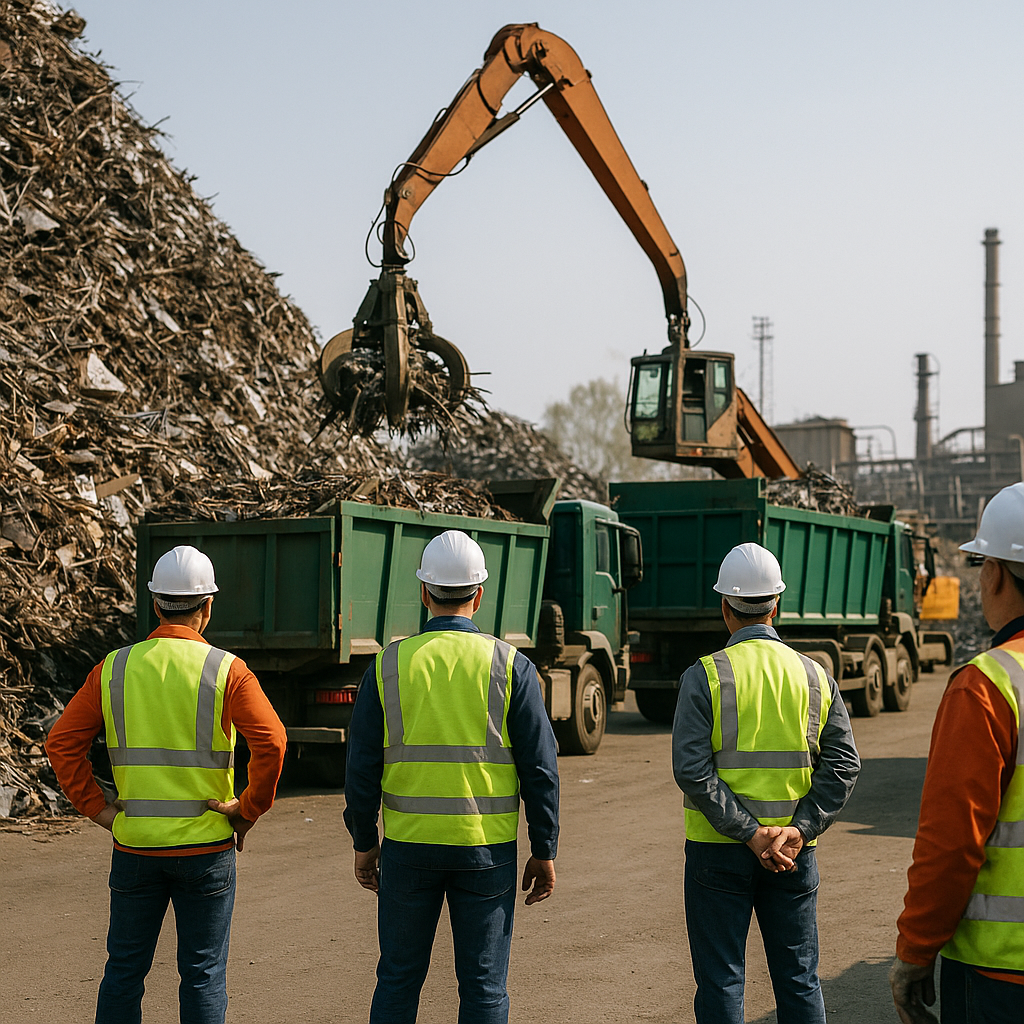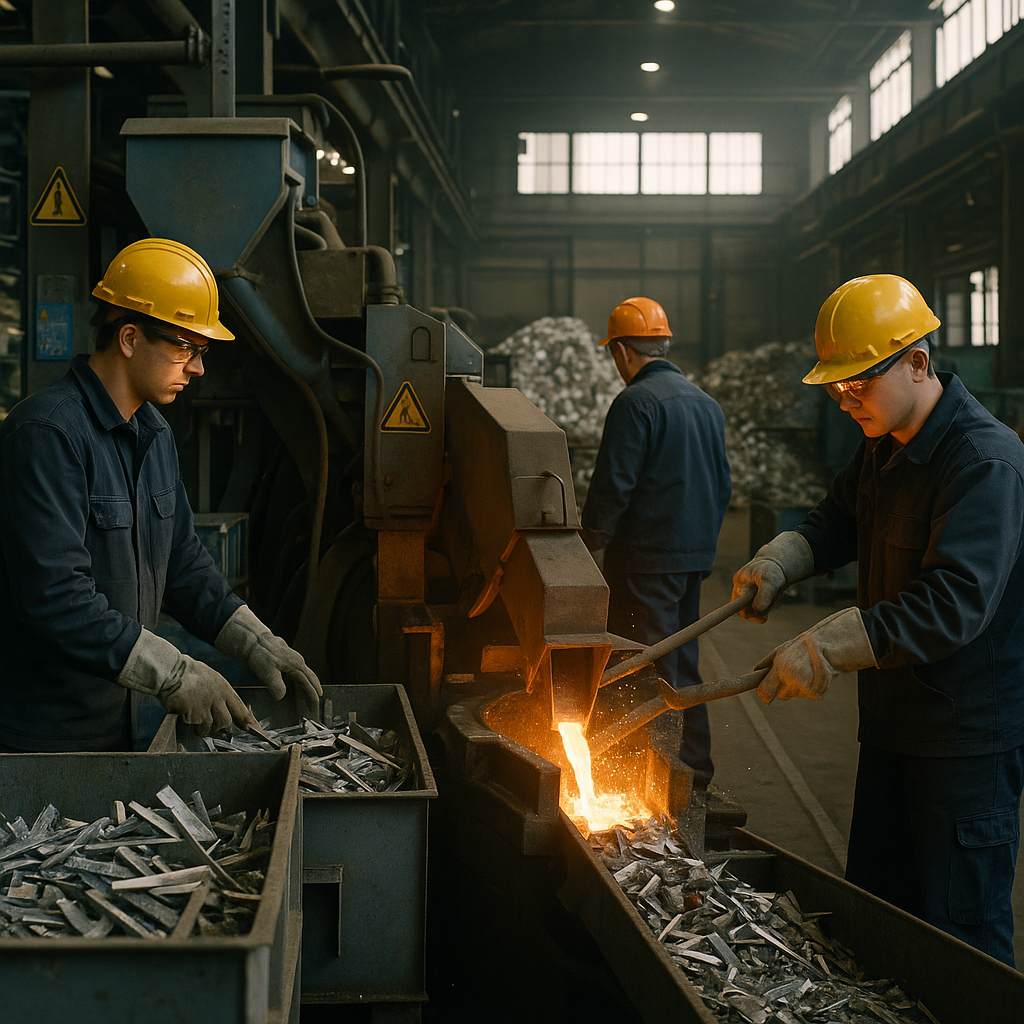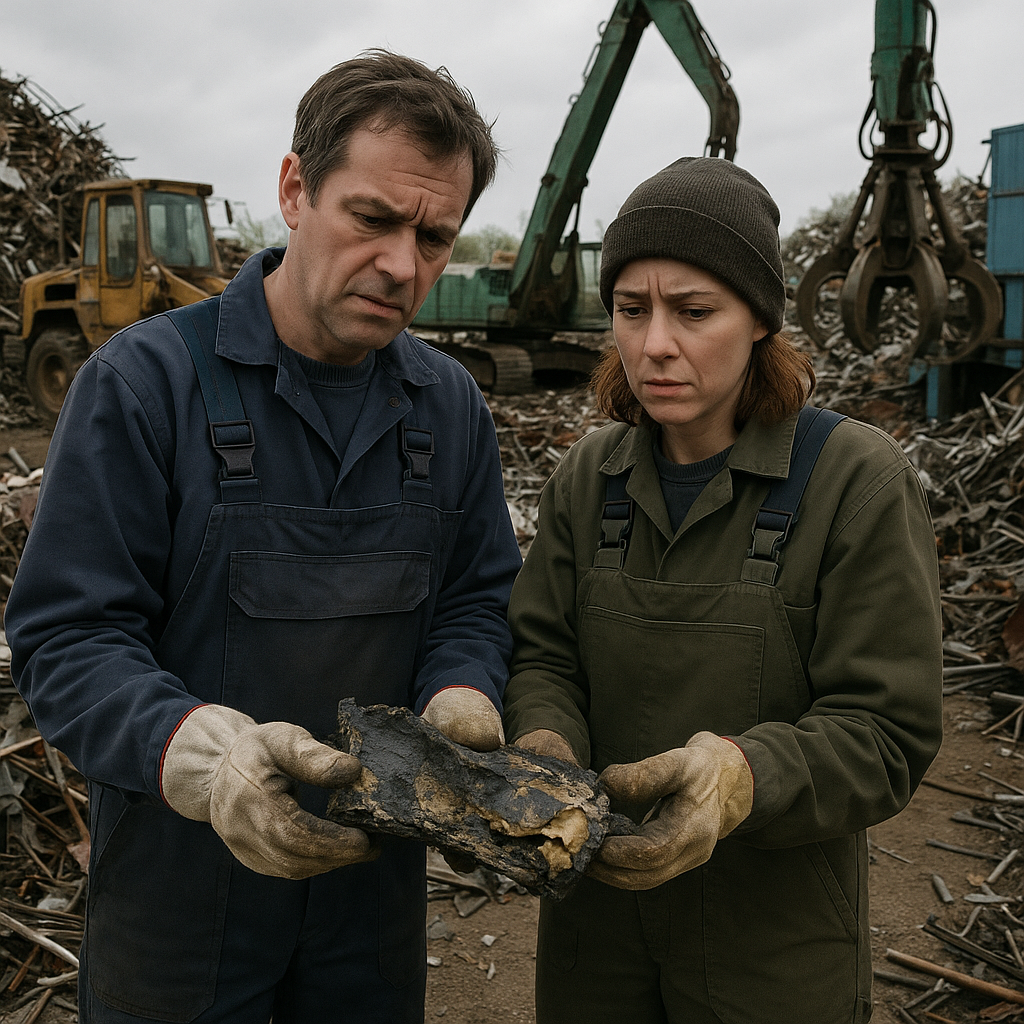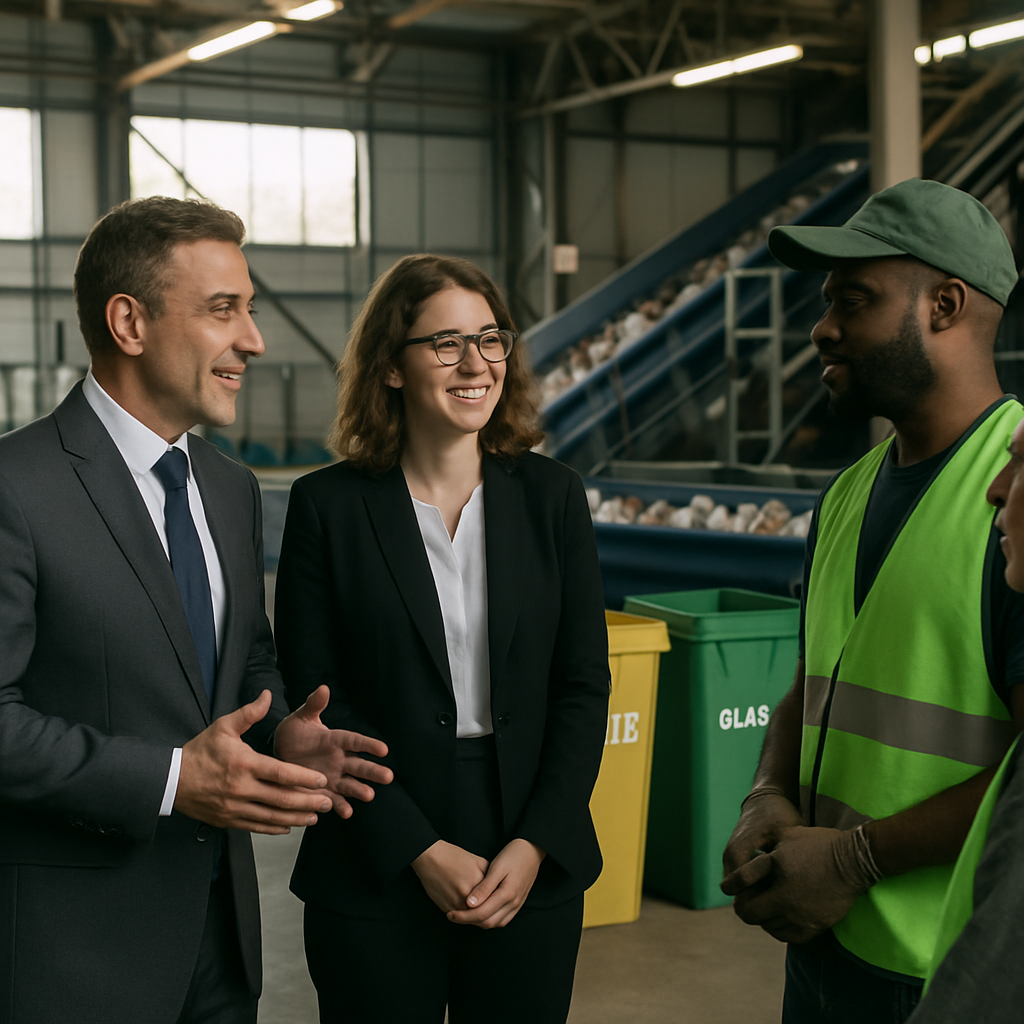5901 Botham Jean Blvd, Dallas, TX 75215
What Is Industrial Metal Waste Recycling? Process, Benefits & How It Works
September 4, 2025Industrial metal waste recycling transforms discarded metal from manufacturing, construction, and other industrial operations into valuable resources. This sustainable process diverts metals from landfills, giving them new life through collection, sorting, processing, and reuse. The metals involved range from steel and iron to aluminum, copper, and other valuable alloys.
Fundamentally, industrial metal waste recycling is a critical environmental solution. When metals end up in landfills, they release toxins like mercury and lead that contaminate soil and water. Recycling prevents this contamination while significantly reducing the energy required to produce new materials. Recycled aluminum requires 95% less energy than mining new aluminum, while copper recycling saves 90% of the energy needed to extract virgin material.
Beyond environmental benefits, industrial metal waste recycling drives economic growth. The industry creates thousands of jobs and generates billions in economic activity annually. Manufacturing sectors rely on recycled metals as cost-effective, reliable resources that help stabilize supply chains and reduce production costs. This circular approach to metal resources transforms industrial waste into a valuable commodity instead of a disposal challenge.
What are the Key Benefits of Recycling Industrial Metal Waste?

Recycling industrial metal waste provides significant environmental and economic benefits for businesses and communities. Metal’s ability to be continuously recycled without degrading makes it especially valuable in waste management. Effectively implemented metal recycling programs create widespread advantages throughout the supply chain.
Reduction in Landfill Waste
A key benefit of recycling industrial metal waste is the significant decrease in materials sent to landfills. Metals occupy valuable space and, unlike organic materials, do not decompose naturally. Instead, they can remain intact for centuries. When metals decompose in landfills, they may release harmful compounds into the soil and groundwater. Recycling prevents such contamination. Ferrous metals, containing iron, can rust and leach into surrounding areas, while non-ferrous metals can emit more toxic compounds over time.
By diverting metal waste from landfills, recycling programs extend the lifespan of existing disposal facilities and reduce the need for new landfill development. This is crucial in regions with limited space or strict waste management regulations.
Energy Conservation
The energy savings from metal recycling are considerable. Manufacturing products from recycled metal requires significantly less energy than processing virgin ore, leading to lower production costs and environmental impact. Recycling aluminum saves up to 95% of the energy needed to produce new aluminum from bauxite ore. For steel, energy savings range from 60-74%. These efficiencies make metal recycling one of the most energy-efficient waste management practices available.
For example, recycling one ton of aluminum saves around 14,000 kilowatt-hours of electricity, enough to power an average household for more than a year. On an industrial scale, these energy savings result in substantial benefits.
Preservation of Natural Resources
Metal ore is a finite resource, and mining often involves extensive land clearing and ecosystem disruption. Recycling industrial metal waste decreases the demand for virgin ore extraction, preserving limited natural resources for the future.
Recycling one ton of steel saves about 2,500 pounds of iron ore, 1,400 pounds of coal, and 120 pounds of limestone, while recycling aluminum means approximately 4 tons of bauxite ore remain undisturbed.
Recycling also conserves auxiliary resources used in mining, such as water, and minimizes potential contamination from chemicals required in metal extraction.
Reduction in Greenhouse Gas Emissions
Recycling metal significantly reduces greenhouse gas emissions. The energy-intensive processes of mining, refining, and manufacturing virgin metals produce vast amounts of carbon dioxide and other gases. Using recycled materials greatly reduces these emissions.
According to the Institute of Scrap Recycling Industries, recycling reduces greenhouse gas emissions by up to 300 million tons annually. Recycling one ton of aluminum prevents around 9 tons of CO2 emissions.
Water and air pollution are also considerably reduced through recycling. Traditional mining and refining release pollutants into water and air, while recycled steel results in an 86% reduction in air pollution and a 76% reduction in water pollution.
Support for a Circular Economy
Industrial metal recycling is central to the circular economy model, which maintains materials in use indefinitely, unlike the traditional linear approach. Metals suit this model particularly well since they can be recycled repeatedly without significant degradation.
This circular approach drives economic growth across the value chain, generating billions annually and supporting jobs in collection, processing, and manufacturing. For businesses, recycling programs can cut raw material costs and help achieve sustainability goals.
Companies often use metal recycling as part of environmental compliance strategies. As regulatory pressures and consumer demand for sustainable practices increase, recycling helps businesses demonstrate environmental responsibility and potentially reduce compliance costs.
How Does the Industrial Metal Recycling Process Work?

The industrial metal recycling process transforms discarded metal materials into valuable resources through a series of specialized steps. Each stage employs advanced technologies to maximize recovery and ensure high-quality recycled metal products.
Collection and Categorization
The process begins with collecting metal scrap from manufacturing facilities, construction sites, and industrial businesses. Materials are initially categorized as either ferrous (containing iron) or non-ferrous (such as copper, aluminum, and brass). This distinction is crucial because different metal types require specific processing methods.
Large recycling operations use designated containers and specialized transportation equipment to efficiently gather materials. Many facilities also implement tracking systems to document the source and type of incoming materials for quality control purposes.
Sorting and Preparation
Once collected, metals undergo thorough sorting. Industrial facilities use multiple technologies to separate different metal types. Large electromagnets efficiently remove ferrous metals from mixed materials. For non-ferrous metals, recyclers use eddy current separators, XRF (X-ray fluorescence) analyzers, and optical sorting systems.
Modern sorting facilities now incorporate artificial intelligence and computer vision systems that can identify and separate materials at high speeds with remarkable accuracy. These advanced systems can distinguish between different metal alloys that would be impossible to differentiate through visual inspection alone.
Shredding and Size Reduction
After sorting, large metal pieces are broken down into smaller fragments. Industrial shredders, hydraulic shears, and granulators reduce metals to uniform sizes that can be efficiently processed in subsequent steps. This increases surface area and allows metals to melt faster during the melting phase.
For automotive and large industrial scrap, specialized shredding equipment can process several tons of material per hour. These powerful machines can reduce an entire vehicle to fist-sized chunks of metal in minutes.
Melting and Purification
The processed metal fragments are transferred to specialized furnaces designed for specific metal types. Electric arc furnaces are commonly used for steel recycling, while reverberatory or induction furnaces may be used for non-ferrous metals.
During melting, impurities such as coatings, paint, and contaminants are removed through various purification techniques. This may include electrolysis for copper purification or chemical treatments to remove unwanted elements. Advanced monitoring systems ensure that the resulting metal meets precise quality specifications.
Solidification and Manufacturing Integration
The purified molten metal is then cooled and formed into ingots, bars, sheets, or other standardized forms. These recycled materials are delivered to manufacturers, serving as raw materials for new product creation. Many industrial recycling operations work directly with manufacturers to create closed-loop recycling systems.
Modern facilities often use automated casting systems that can precisely control the cooling rate and final properties of the recycled metal. This level of control ensures that recycled metals perform identically to virgin materials in manufacturing applications.
The entire process significantly reduces energy consumption compared to mining and processing raw ores. For aluminum, recycling saves approximately 95% of the energy required to produce the same amount from bauxite ore. Steel recycling saves about 60% of the energy compared to virgin production.
| Material Type | Recycling Technology | Description |
|---|---|---|
| Copper, Tin, Nickel, Silver | Electrowinning | Extraction from solution using electrical currents. |
| Non-Ferrous Metals | Precipitation | Recovery from aqueous solutions, often through pH adjustment. |
| Aluminum and Others in Zobra | Sensor-based Methods | Detection and sorting using sensors, effective in separating mixtures. |
Through these sophisticated processes, the industrial metal recycling industry diverts millions of tons of material from landfills annually while providing essential raw materials for manufacturing. As technology continues to advance, these processes become increasingly efficient, allowing for even higher recovery rates and better-quality recycled metals.
What Challenges Face Industrial Metal Waste Recycling?
Sorting Complexity and Contamination Issues
Inefficient sorting is a major hurdle in industrial metal recycling. Mixing different metals during collection or processing leads to contamination, significantly reducing the value and usability of recycled materials. For example, even a small amount of copper mixed with aluminum can compromise the load’s structural integrity.
The sorting challenge extends beyond separating metals. Many industrial components include various materials like plastic casings, rubber seals, or hazardous chemicals that must be removed before processing. Each non-metal component adds to the processing time and cost.
Modern recycling facilities often use magnetic separators to distinguish ferrous from non-ferrous metals, but this is only part of the solution. The true challenge lies in efficiently differentiating between similar metal types, like various grades of aluminum or specialized alloys.
Logistical and Transportation Barriers
Handling industrial metal waste presents substantial challenges. Scrap metal’s heavy, bulky, and often irregular shape makes transportation costly and energy-intensive. Companies must carefully plan collection routes and loading procedures for maximum efficiency.
Storage space limitations pose additional complications. Without proper organization, industrial scrap metal can cause cluttered workspaces, creating safety hazards and reducing operational efficiency. Companies need to allocate adequate storage areas and implement systems to prevent theft of valuable metals.
Weather exposure during transportation and storage can cause oxidation and corrosion, reducing scrap metal’s quality and value. Protective coverings and moisture-resistant storage solutions are essential but increase overall recycling costs.
Material Quality and Purity Concerns
Impurities significantly impact the quality of recycled metals. Coatings, paints, and other surface treatments often contain chemicals that can compromise recycling. These contaminants need removal through cleaning or chemical treatment before reprocessing the metal.
End-of-life industrial products pose challenges due to complex compositions. Equipment like machinery, vehicles, and electronic components often contain mixed metals bonded together, requiring specialized separation techniques. Properly identifying and separating these materials is time-intensive and raises processing costs.
Even after separation, achieving high purity standards is difficult. Industries like automotive, aerospace, and electronics demand metals meeting strict quality specifications, making purification critically important.
| Challenge | Description |
|---|---|
| Sorting Complexity | Inefficient sorting leading to contamination; difficulty in separating metal types and removing non-metal components. |
| Contamination | Presence of non-metal materials like plastic and rubber, complicating processing and increasing costs. |
| Market Volatility | Fluctuating global market prices for metals affecting profitability and stability. |
| Infrastructure Limitations | Insufficient or outdated facilities causing inefficiencies in collection, sorting, and processing. |
| Quality Control | Ensuring recycled metals meet industry standards, which is challenging without advanced technology. |
| Logistical Barriers | Challenges with transporting heavy and bulky scrap, and storage issues including space and weather protection. |
| Regulatory Compliance | Keeping up with changing environmental regulations adds complexity and potential costs. |
| Technological Investment | Need for substantial investment in advanced sorting and processing technology to improve efficiency. |
| Public Awareness | Low participation and awareness in metal recycling can reduce efficiency and program effectiveness. |
Technological and Economic Hurdles
The use of advanced sorting and purification technologies presents both a solution and a challenge. Innovations such as optical sorting systems, eddy current separators, and AI-powered sorting equipment can greatly enhance efficiency, but require substantial upfront investment that many recycling operations find difficult to finance.
Market fluctuations add uncertainty. Global prices for recycled metals vary with industrial demand, energy costs, and economic conditions. These unpredictable shifts make it challenging for recycling businesses to plan long-term investments in infrastructure and technology.
Regulatory compliance adds complexity. Environmental regulations governing the handling, processing, and transportation of metal waste continue to evolve, requiring recyclers to stay updated with changes. While aimed at environmental protection, adapting to these regulations often requires operational changes and additional costs.
How Can Businesses Implement Effective Industrial Metal Recycling?

Implementing effective industrial metal recycling is not only environmentally responsible but also a strategic decision that can reduce waste management costs and potentially create new revenue streams. Companies of all sizes can enhance their approach to metal waste with thoughtful planning and execution.
Conduct a Waste Audit and Set Clear Goals
Before implementing any recycling program, businesses should thoroughly assess their metal waste streams. A comprehensive waste audit reveals what types of metals are generated and in what quantities. This crucial first step provides baseline data for measuring future improvements.
Based on audit findings, establish specific, measurable recycling goals. For manufacturing businesses, this might mean achieving a 75% recovery rate for aluminum scrap. Construction companies might target complete recycling of all structural steel from demolition projects. Clear metrics drive accountability and help track program effectiveness.
Invest in Sorting and Processing Technologies
Proper metal separation significantly increases recycling value. While small businesses can start with manual sorting systems using well-labeled bins, larger operations benefit from investing in advanced technologies.
Magnetic separators efficiently extract ferrous metals like iron and steel, while eddy current separators recover non-ferrous metals such as aluminum and copper. For companies generating substantial metal waste, balers and compactors reduce storage requirements and transportation costs. These investments typically pay for themselves through higher scrap values and reduced waste disposal fees.
Train Employees on Proper Waste Segregation
Even the best-designed recycling system fails without employee participation. Comprehensive training programs ensure everyone understands what metals can be recycled and how to properly segregate them. Regular refresher sessions keep recycling practices top of mind.
Many successful programs designate recycling champions within each department who can answer questions and monitor compliance. Visual aids near collection points help workers quickly identify where different metals belong. Regular feedback on recycling performance motivates continued participation.
Partner with Reliable Recycling Service Providers
Selecting the right recycling partner is crucial for program success. Look for recycling services with specific experience handling industrial metal waste and the capacity to process your volume. A good partner provides collection containers, regular pickups, and transparent reporting on material weights and values.
For larger businesses, national recycling companies can offer consistent service across multiple locations. Smaller operations may find better value with local scrap yards that provide personalized service. Either way, verify that your chosen partner follows environmentally responsible processing methods and complies with all regulations.
| Business Size | Recycling Strategy | Benefits | Potential Challenges |
|---|---|---|---|
| Small | Manual sorting using well-labeled bins | Cost-effective, easy to manage | Limited resources for advanced technologies |
| Medium | Investment in balers and compactors | Reduced storage and transportation costs | Initial investment in machinery |
| Large | Advanced technologies, automated systems | Increased efficiency, higher scrap value | High upfront costs, technology maintenance |
Implement a Circular Economy Model
Forward-thinking businesses are moving toward circular economy models. This approach designs waste out of the system from the start. Consider how recycled metals can be incorporated back into your supply chain or products.
Metal fabricators can work with suppliers who provide materials with recycled content. Electronics manufacturers can design products for easy disassembly and metal recovery at end of life. The circular approach reduces environmental impact while potentially creating cost savings through resource efficiency.
Establish Take-Back Programs
Businesses that produce metal-containing products can establish take-back programs to recover materials once customers are finished with them. These programs create a reliable stream of recyclable metals while strengthening customer relationships.
Take-back initiatives work particularly well for industrial equipment, electronic devices, and metal packaging. Some companies offer incentives like discounts on new purchases when customers return old products for recycling. This strategy supports both sustainability goals and customer retention.
Conduct Regular Audits and Monitoring
Ongoing program assessment keeps recycling efforts on track. Regular waste audits reveal if segregation practices are improving and identify new opportunities for metal recovery. Tracking metrics like recycling rates and waste diversion percentages helps quantify program success.
Monitoring should also include periodic reviews of recycling partnerships and technologies to ensure they continue meeting your needs. Businesses often find that recycling opportunities expand as they become more familiar with the process and as recycling technologies advance.
Ensure Regulatory Compliance
Industrial metal recycling is subject to various regulations depending on your location and industry. Staying compliant requires ongoing attention to changing requirements. Many recycling service providers can help navigate these complexities, but ultimately compliance remains the business’s responsibility.
Key regulatory areas include proper handling of hazardous materials that may be attached to metals, documentation of waste transfers, and environmental permits for certain processing activities. Building compliance into your recycling program from the start prevents costly issues later.
Collaborate Across Industries
Some of the most successful metal recycling initiatives involve collaboration between businesses. One company’s metal waste can become another’s raw material. Industry associations often facilitate these connections, helping members identify potential partners.
Collaborative approaches work particularly well in industrial parks or manufacturing clusters where transportation distances are minimal. These arrangements create stable outlets for recycled metals while reducing costs for all participants.
Conclusion: The Future of Industrial Metal Waste Recycling

Industrial metal waste recycling is a cornerstone of sustainable industrial development. Transforming discarded metals into valuable resources provides a solution that meets both environmental and economic needs. Advanced technologies, including AI-driven sorting systems, deep learning applications, and innovative chemical recycling, are transforming how we process and recover metals from industrial waste.
These advances signal a future where industrial metal recycling becomes more efficient and integrated into manufacturing processes. The benefits extend beyond environmental protection to include cost savings, stronger supply chains, and reduced carbon footprints. As industries face increasing pressure to adopt sustainable practices, metal recycling stands as a proven strategy aligning environmental responsibility with business success. For your industrial metal recycling needs, contact Okon Recycling at 214-717-4083.
